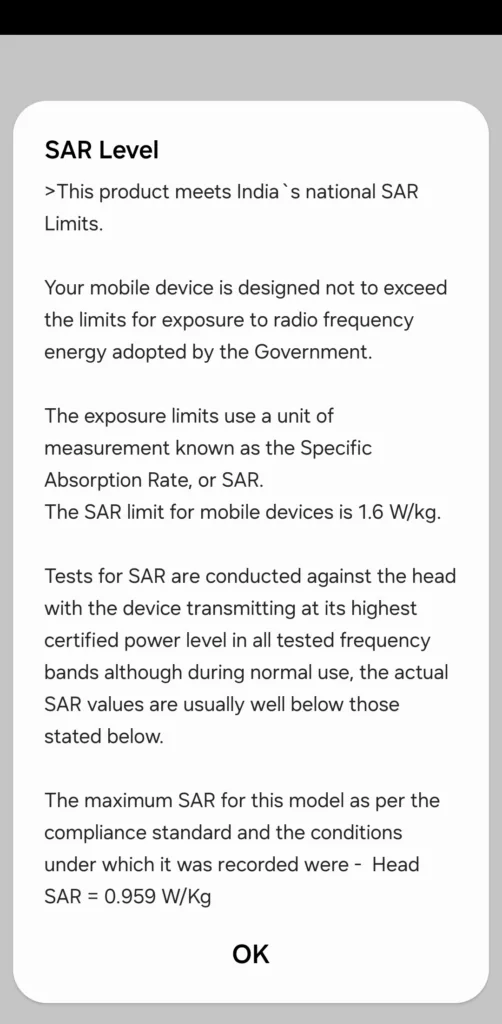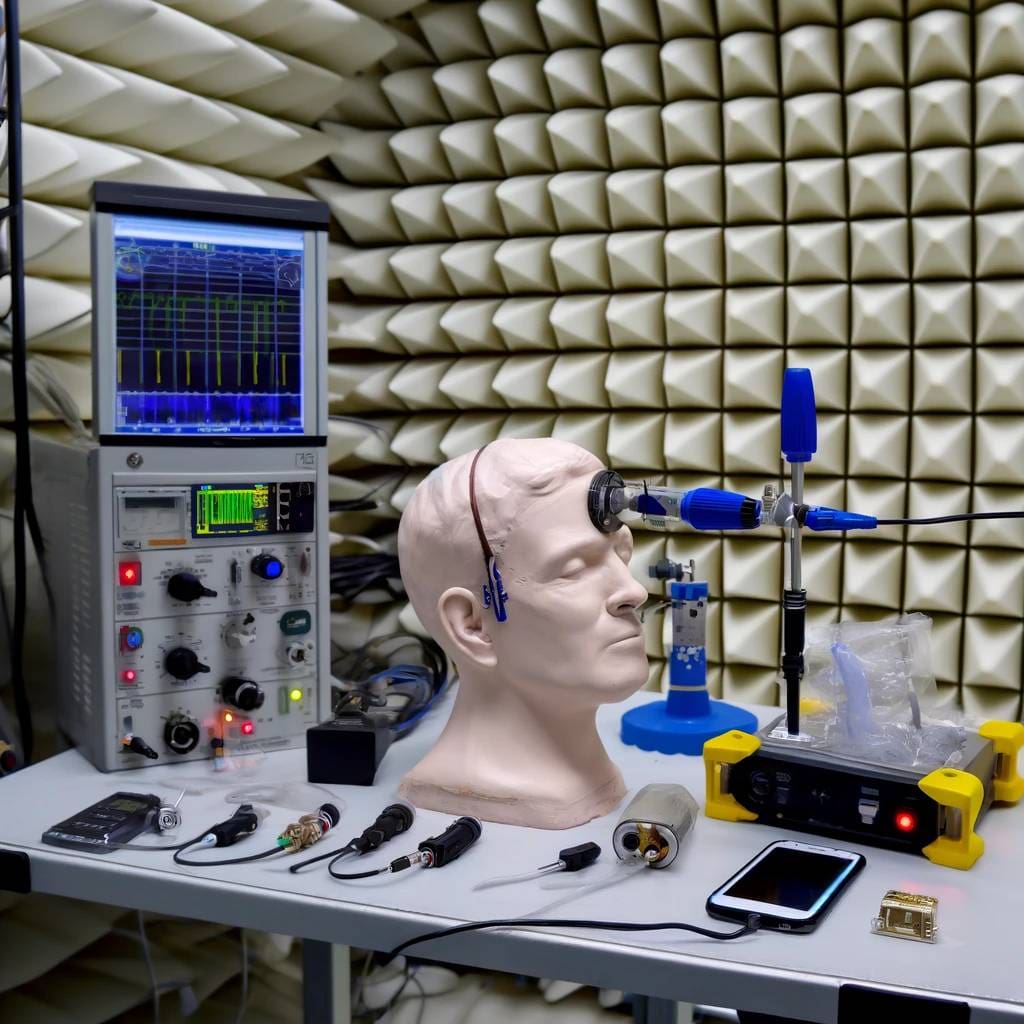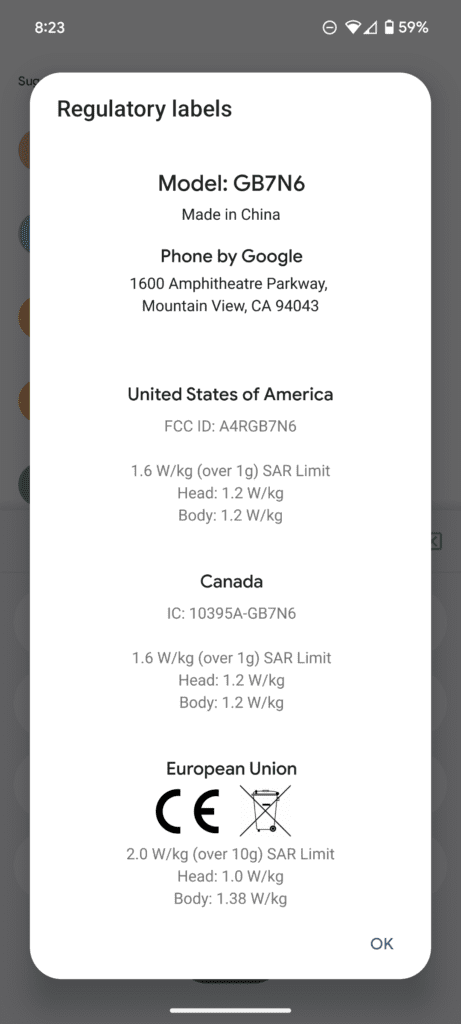Considering upgrading your phone? How about choosing from one of these 10 low SAR phones for extra-EMF protection?
What Is SAR and Why Should You Care?
Let’s begin with a simple activity. Take out your mobile phone and dial *#07#.
You should now be looking at a screen displaying your phone’s SAR (Specific Absorption Rate) value.
By entering this code, we can assess your phone’s SAR level, which indicates the amount of radiation your body may absorb while using the device.
Note: If this code doesn’t work on your device, you can go to your phone’s settings, and depending on your device, follow the instructions below.
Android: Settings>>About Phone>>Legal Information>>Safety Information>>RF Exposure

Want toSlashYour EMF Health Risks?
Want to Slash Your EMF Health Risks?
Good! Learn the one small change you should make right now.
iPhone: Settings>>General>>Legal & Regulatory>>RF Exposure>>SAR
Each country sets regulatory limits on these values. But why are these limits important?
The Importance of SAR Limits
All wireless devices emit radiation"Radiation" in the context of Electromagnetic Fields (EMF) refers to the process by which energy is emitted and transmitted through space or a material medium in the form of electromagnetic.... And all of them have the potential to emit EMF to a degree that could pose a serious threat to your health.
To manage this risk, regulatory bodies worldwide enforce limits on how much radiation your body can absorb from these devices.
These limits are based on a test called the Specific Absorption Rate (SAR) test. Before these gadgets hit the shelves, manufacturers must rigorously test them to ensure they are at or below the set SAR limits.
How is SAR Measured?
To measure SAR, wireless gadget manufacturers use a standardized model known as a Specific Anthropomorphic Mannequin (SAM). This model is designed to mimic the electrical properties and tissue composition of the human body and is filled with a liquid that simulates human tissue.
During testing, they turn on all the wireless functions of the device, simulating its maximum power output.
They then place the device in various positions and orientations around the SAM to replicate typical use scenarios, such as being held next to the ear or carried in a pocket.
Sensors embedded within the SAM measure the radiation that the liquid absorbs. They then use this data to calculate the SAR value, considering the highest radiation exposure in all tested conditions.
SAR tests need to be performed in specialized laboratories where they can control the device’s operational settings and test it at different levels of its power"Power" in a scientific context refers to the rate at which work is done or energy is transferred. In simpler terms, it's how fast something is using energy. For example,... cycle and under conditions that would lead to maximum power output, such as when signal reception is poor.
If the device has multiple antennas or operates on several frequency bands, they perform various tests to ensure that the cumulative radiation exposure remains within the set limits.
They then document each test scenario and finalize the SAR value based on the highest recorded levels.
Understanding SAR Values
After complete testing, we get a value like this:
And, frankly, for most of us, these numbers don’t mean much. But don’t let it scare you. Simplifying complex scientific topics and creating a bridge between EMF science and the general public is what we do here at SYB.
So, here’s what your phone’s SAR value means in simple terms.
SAR is basically the speed limit for your wireless devices. Just like a speed limit prevents cars from going too fast and causing accidents, SAR limits keep the radiation from your devices under control to protect your health.
In the United States, the SAR limit is 1.6 W/kg, averaged over one gram of tissue. This means any device sold must not emit more than 1.6 watts of radiation energy per kilogram of your body weight, ensuring it stays within safe exposure levels.
In simple terms, think of your body as a sponge and EMF as water.
According to this rule, your body (the sponge) should not soak up more than 1.6 “cups” of water (radiation) per kilogram (about 2.2 lbs) of your body weight.
Now imagine your smartphone has a SAR value of 1.2 W/kg. This means that when you’re using your phone at its highest power level, the amount of radiation your body absorbs is well within the safe limit according to the FCC.
It’s like driving at 50 mph in a 65-mph zone—safe and with a comfortable margin.
Meanwhile, a Bluetooth headset might have an even lower SAR value, like 0.3 W/kg. This is like walking in the park instead of driving on the highway—much lower risk and minimal exposure.
SAR Legal Limits Around the World
Just like speed limits vary from one country to another, the legal limits for Specific Absorption Rate (SAR) values differ across the globe to ensure safety tailored to regional standards.
As I already mentioned, in the United States, the Federal Communications Commission (FCC) has set a SAR limit of 1.6 W/kg, averaged over one gram of tissue.
Across the Atlantic, the European Union follows a slightly different standard. The SAR limit in Europe is 2 W/kg, averaged over 10 grams of tissue. Although this limit appears higher, the averaging over a larger mass of tissue means the overall exposure is still within “safe” boundaries.
Other countries around the world adopt one of these two standards or establish their own limits based on local research and regulatory frameworks. For instance, Canada, Australia, and India adhere to the same 1.6 W/kg limit, whereas China follows the 2W/kg limit.
The Problem With SAR
Because SAR is a globally recognized limit and the test itself requires specialized laboratories, it’s more than enough to make the masses believe that it’s the perfect measurement. However, in reality, it has several flaws. Here, have a look.
Thermal vs. Non-Thermal Effects
The current EMF safety standards for devices with wireless connectivity are based on the concept of the thermal effect.
The thermal effect refers to the radiation’s ability to heat your tissues significantly, which can cause serious health damage.
Consequently, SAR measurements only account for the thermal effects of EMF radiation on health.
You can learn more about it in my post, “The Thermal Effect of EMF & Its Role in Radiation Safety Standards.”
However, there is a fundamental flaw in this approach.
Scientists have discovered that EMF exposure can cause health effects at levels much lower than those causing thermal effects.
Non-thermal effects of EMF include a wide range of biological impacts that occur without any noticeable increase in tissue temperature. These effects can include oxidative stress, DNA damage, altered cell membrane function, and disruptions in cellular communication.
And since non-thermal effects are not considered during SAR testing, this method overlooks a significant aspect of how EMF affects our health.
Self-Reported Testing
While regulatory agencies define SAR standards, the tests themselves are commissioned and designed by the companies that manufacture the devices.
This means the results are self-reported, and not independently verified as many consumers might assume.
The integrity of these tests relies heavily on the honesty and accuracy of the companies.
Unrealistic Testing Conditions
In addition to self-reporting, companies can control the test conditions, allowing them to test their products in ways that do not reflect typical phone usage.
This leads to disclaimers like Apple’s, advising against letting your phone touch your body.
Since most people do not read the fine print in the manual, they end up using their phones normally and exposing themselves to significantly more EMF than recommended.
The companies bear no legal liability for this.
Moreover, this is not just a minor ethical issue; this flawed testing system has led to serious cases such as the PhoneGate scandal.
In 2016, the French government tested around 300 phones and found that 88% of them emitted more radiation than reported by the manufacturers.
Some phones even exceeded the legal radiation limits, highlighting the discrepancies and potential risks associated with relying solely on SAR values for safety assurances.
So, what’s even the point of buying devices with low SAR values?
To Err on The Side of Caution
Despite its flaws, SAR is still the only standardized measure we have for assessing EMF exposure from devices.
While not perfect, choosing devices with lower SAR values can still be a practical step toward reducing your overall exposure. It’s a way to err on the side of caution until better measures are available.
Given how often we use our phones and their proximity to our bodies, here’s a list of the top 10 low SAR phones launched in 2024 to help you make safer choices if you’re thinking about upgrading.
ZTE Blade V10
SAR (head): 0.13 W/kg
SAR (body): 0.22 W/kg
The ZTE Blade V10 offers one of the lowest SAR values. It features a 6.3-inch Full HD+ display, a 16 MP + 5 MP dual rear camera setup, and a 32 MP front camera for high-quality selfies.
The device is powered by an octa-core processor and 4GB of RAM, ensuring smooth performance.
Samsung Galaxy Note 10+
SAR (head): 0.19 W/kg
SAR (body): 0.28 W/kg
Known for its powerful performance, the Galaxy Note 10+ features a 6.8-inch Dynamic AMOLED display, Exynos 9825/Snapdragon 855 processor, and up to 12GB of RAM.
The S-Pen stylus adds to its productivity features, making it a great choice for professionals.
Samsung Galaxy Note 10
SAR (head): 0.21 W/kg
SAR (body): 0.29 W/kg
Slightly smaller than the Note 10+, the Galaxy Note 10 has a 6.3-inch Dynamic AMOLED display and similar high-end specifications.
It also supports the S-Pen, making it a versatile device for both work and play.
LG G7 ThinQ
SAR (head): 0.24 W/kg
SAR (body): 0.32 W/kg
The LG G7 ThinQ offers a 6.1-inch QHD+ display with superb brightness and clarity. It features AI enhancements in its dual 16 MP rear cameras, delivering excellent photography results.
The phone also includes a Boombox speaker for high-quality audio.
Huawei P30
SAR (head): 0.33 W/kg
SAR (body): 0.41 W/kg
The Huawei P30 is renowned for its camera capabilities, featuring a Leica triple camera system (40 MP + 16 MP + 8 MP).
It also has a 6.1-inch OLED display and is powered by the Kirin 980 chipset, offering strong performance and efficiency.
Xiaomi Redmi Note 2
SAR (head): 0.34 W/kg
SAR (body): 0.42 W/kg
The Xiaomi Redmi Note 2 provides great value for its price. It comes with a 5.5-inch Full HD display, a MediaTek Helio X10 processor, and a 13 MP rear camera.
This budget-friendly device is known for its decent performance and affordability.
Honor X8
SAR (head): 0.84 W/kg
SAR (body): 1.02 W/kg
The Honor X8 offers a large 6.7-inch Full HD+ display and a versatile quad-camera setup with a 64 MP main sensor.
It runs on the Snapdragon 680 processor and provides a good balance of performance and battery life.
Apple iPhone 11
SAR (head): 0.95 W/kg
SAR (body): 1.13 W/kg
The iPhone 11 features a 6.1-inch Liquid Retina display, A13 Bionic chip, and a dual-camera system with 12 MP ultra-wide and wide lenses.
It’s known for its excellent performance, camera quality, and integration with Apple’s ecosystem.
Realme GT Neo 3
SAR (head): 0.91 W/kg
SAR (body): 1.09 W/kg
The Realme GT Neo 3 is geared towards gamers with its MediaTek Dimensity 8100 chipset and 120 Hz AMOLED display.
It also boasts a 50 MP triple camera setup and fast charging capabilities.
Samsung Galaxy A53 5G
SAR (head): 0.90 W/kg
SAR (body): 1.08 W/kg
Review: The Galaxy A53 5G"5G" refers to the fifth generation of wireless communication technology, a step up from the previous 4G, 3G, and 2G networks. It's designed to provide faster internet speeds, more reliable... offers a 6.5-inch Super AMOLED display with a 120 Hz refresh rate.
It has a quad-camera system, including a 64 MP main sensor, and is powered by the Exynos 1280 chipset, providing a solid 5G experience at a mid-range price.
Final Thoughts
In our fast-paced digital world, it’s easy to overlook the subtle, invisible elements that impact our health, like electromagnetic radiationElectromagnetic radiation refers to the waves of the electromagnetic field, propagating through space, carrying electromagnetic radiant energy. It includes a wide range of electromagnetic waves, from very long radio waves... from our beloved gadgets.
The journey of choosing a low SAR phone isn’t just about numbers and limits—it’s about making a conscious choice to prioritize your well-being while staying connected.
Each phone on this list not only meets stringent safety standards but also offers cutting-edge features that cater to various lifestyles, proving that you don’t have to compromise on performance or style for safety.
As you ponder your next upgrade, remember that safeguarding your health goes beyond picking the right device. You also want to create simple, effective habits that make living with technology safer and healthier.
Speaking of which, did you know the best EMF protection is always free? Discover easy and impactful ways to protect yourself and your loved ones from EMF’s effects in my post, “10 Best EMF Protection Tips for a Safer, Healthier Life.”












